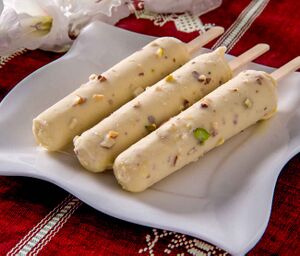Koppai: Difference between revisions
No edit summary |
No edit summary |
||
| Line 19: | Line 19: | ||
Koppai is a frozen dairy dessert originating in [[History of Central Orient|Central Orient]] from the 16th century. It is often described as "traditional [[Orient]]al ice cream" for it's popularity historically and into present day. Koppai is a traditional sweet of the Oriental subcontinent, where it is commonly sold by street vendors or by markets. It is popular in [[Kotowari]], [[Mahana]], [[Tamurin]], [[Orioni]], [[Qubdi]] as well as much of former Orinese colonial territory such as the [[Bainbridge Islands]] and [[Burkini]]. It is also part of the national cuisines of [[Kotowari]], [[Mahana]] and [[Mekabiri]]. | Koppai is a frozen dairy dessert originating in [[History of Central Orient|Central Orient]] from the 16th century. It is often described as "traditional [[Orient]]al ice cream" for it's popularity historically and into present day. Koppai is a traditional sweet of the Oriental subcontinent, where it is commonly sold by street vendors or by markets. It is popular in [[Kotowari]], [[Mahana]], [[Tamurin]], [[Orioni]], [[Qubdi]] as well as much of former Orinese colonial territory such as the [[Bainbridge Islands]] and [[Burkini]]. It is also part of the national cuisines of [[Kotowari]], [[Mahana]] and [[Mekabiri]]. | ||
Koppai is much denser and creamier than usual ice cream. It comes in many flavours, with the traditional flavours including {{wp|rose}}, {{wp|paan}}, {{wp|mango}}, {{wp|safron}} and chilli oil. Modern popular flavours include {{wp|apple}}, {{wp|strawberry}}, {{wp|peanut}} and {{wp|orange}}. Unlike ice cream, koppai is not whipped, resulting in a solid, dense dessert similar to frozen custard. | Koppai is much denser and creamier than usual ice cream. It comes in many flavours, with the traditional flavours including {{wp|rose}}, {{wp|paan}}, {{wp|mango}}, {{wp|safron}} and chilli oil. Modern popular flavours include {{wp|apple}}, {{wp|strawberry}}, {{wp|peanut}} and {{wp|orange}}. Unlike ice cream, koppai is not whipped, resulting in a solid, dense dessert similar to frozen custard. Thus, it is sometimes considered a distinct category of frozen dairy-based dessert. The density of koppai causes it to melt more slowly than ice cream, making it ideal for the warm countries which it is most popular. | ||
==Name== | |||
The word ''koppai'' originates from the [[Kotowari|Bankran peninsula]], where the dessert originates, and means "covered cup" in {{wp|Tamil|Ramil}}. | |||
==History== | ==History== | ||
The dessert is believed to have first originated in the Bankran peninsula of [[Kotowari]] in the 16th century. | |||
==Preparation== | ==Preparation== | ||
==Gallery== | ==Gallery== | ||
Revision as of 14:14, 10 July 2022
 Koppai served on a plēṭa | |
| Type | Ice cream |
|---|---|
| Course | Dessert |
| Place of origin | |
| Region or state | Central Orient |
| Associated national cuisine | Kotowari, Mahana, Mekabiri |
| Main ingredients | Milk, sugar |
Koppai is a frozen dairy dessert originating in Central Orient from the 16th century. It is often described as "traditional Oriental ice cream" for it's popularity historically and into present day. Koppai is a traditional sweet of the Oriental subcontinent, where it is commonly sold by street vendors or by markets. It is popular in Kotowari, Mahana, Tamurin, Orioni, Qubdi as well as much of former Orinese colonial territory such as the Bainbridge Islands and Burkini. It is also part of the national cuisines of Kotowari, Mahana and Mekabiri.
Koppai is much denser and creamier than usual ice cream. It comes in many flavours, with the traditional flavours including rose, paan, mango, safron and chilli oil. Modern popular flavours include apple, strawberry, peanut and orange. Unlike ice cream, koppai is not whipped, resulting in a solid, dense dessert similar to frozen custard. Thus, it is sometimes considered a distinct category of frozen dairy-based dessert. The density of koppai causes it to melt more slowly than ice cream, making it ideal for the warm countries which it is most popular.
Name
The word koppai originates from the Bankran peninsula, where the dessert originates, and means "covered cup" in Ramil.
History
The dessert is believed to have first originated in the Bankran peninsula of Kotowari in the 16th century.